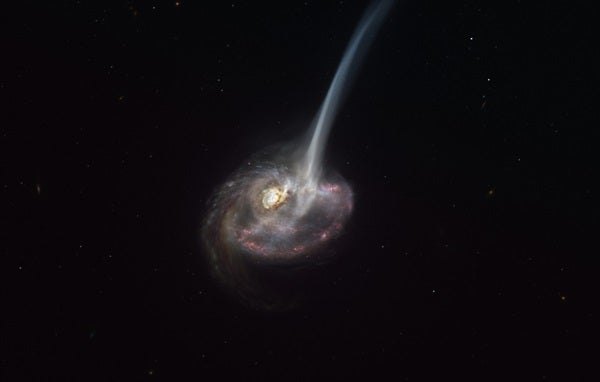As galaxies evolve, they undergo several changes. One of the most significant is the cessation of star formation. Once a galaxy stops creating stars, it becomes old and quiescent, losing the youthful shine that comes with giving birth to new stellar life. Astronomers aren’t entirely sure, however, exactly what shuts down a galaxy’s star formation, or even whether all galaxies grow old in the same way.
Now, a team of European-led astronomers have spotted one possible cause of galactic aging: cosmic collisions. The researchers spotted two merging galaxies in the early universe and noticed that the mash-up is ripping away the larger galaxy’s star-forming fuel, potentially putting an end to its ability to form new suns. The new find was published January 11 in Nature Astronomy.
A chance collision
The team was using the Atacama Large Millimeter/submillimeter Array (ALMA) to study cold gas in a sample of more than 100 distant galaxies. By chance, they stumbled across ID2299, the result of a recent merger between two galaxies. Viewed as it was when the universe was just 4.5 billion years old, the researchers calculated ID2299 is ejecting gas a rate of 10,000 solar masses per year.
In other words, it’s blasting nearly 50 percent of its available star-forming fuel into space. The researchers think this strange ejection event might be a result of a recent merger that gravitationally disrupted and stretched out the galaxies’ gas into a long tidal tail. Based on their findings, they predict that within a few hundred million years — a cosmic eyeblink — the loss of gas will cause ID2299 to stop forming new stars.
“This might have huge consequences on our understanding of what actually shapes the evolution of galaxies,” study co-author Jeremy Fensch of the Centre de Recherche Astrophysique de Lyon, France, said in a press release. That’s because galaxy mergers aren’t generally considered an important mechanism for turning off star formation.
Instead, astronomers usually attribute such “quenching” of star formation to the heat generated by rapid star formation itself, or from the winds and outbursts produced by a galaxy’s central supermassive black hole. Heating is a death sentence for budding stars because hot gas can’t condense enough to create the conditions necessary for nuclear fusion to begin. Only when interstellar gas is quite cold, around –424 degrees Fahrenheit (–253 degrees Celsius), can it fully collapse under its own gravity and form a new star.
Worth reconsidering
This find now has astronomers thinking that other factors may be at work, too.
“Our research provides compelling evidence that the gas being flung from ID2299 is likely to have been tidally ejected because of the merger between two gas-rich spiral galaxies,” said lead author Annagrazia Puglisi of Durham University’s Centre for Extragalactic Astronomy in the U.K. “The gravitational interaction between two galaxies can thus provide sufficient angular momentum to kick out part of the gas into the galaxy surroundings,” she said. It “suggests that mergers are also capable of altering the future evolution of a galaxy by limiting its ability to form stars over millions of years.”
So, she concluded, mergers “deserve more investigation when thinking about the factors that limit galaxy growth.”










